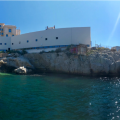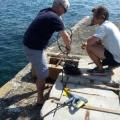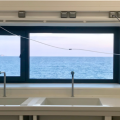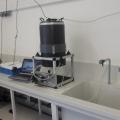First step of the Sea Water Sensing Laboratory @MIO Marseille (SSL@MM)
SSLAMM is a MIO laboratory located at the Endoume Marine Station (Figure 1) with a twofold objective: first, to simultaneously measure several hydrological, biogeochemical, microbiological and chemical variables of seawater at the same site using automated sensors and regular sampling.
The second objective of SSLAMM is to provide an instrumented platform and an environment conducive to the development and validation of sensors, with automation of data acquisition. SSLAMM also allows researchers and students to be hosted for research projects and data matching, under optimal working conditions while benefiting from natural seawater, extracted in situ.
 Figure 1 Left: Building 4 of the Endoume Marine Station and the cove, the pumping point is located at a depth of 4 m at the end of the dike in the centre of the cove. Right: cleaning the nozzle at high pressure
Figure 1 Left: Building 4 of the Endoume Marine Station and the cove, the pumping point is located at a depth of 4 m at the end of the dike in the centre of the cove. Right: cleaning the nozzle at high pressure
Since Wednesday 18 September 2019, the 300 kg peristaltic pump that transports seawater from the cove to the laboratory has been in operation. The water reaches a pressure <1 bar with a flow rate close to 15 dm3/min, divided into 6 taps. The sea water flows continuously into the laboratory. The OSU PYTHEAS diving department has installed the strainer and is responsible for its weekly cleaning. The seawater circuit has been entirely designed to have a minimal influence on the biological and physico-chemical quality of the pumped seawater (peristaltic pump to avoid cavitation, clean trace-metal materials) benefiting from mechanical cleaning in the hydraulic part between the pump and the sampling point (high pressure ferret, figure 1) and chemical cleaning in the laboratory part.
The first automated sensors have been installed, which allow continuous analysis of gaseous mercury in the atmosphere (since 21 May 2019) and in seawater (Lars-Eric Heimbürger-Boavida, CEM team, Figure 2), counting and resolution of phytoplankton functional groups by automated flow cytometry (Melilotus Thyssen, CYBELE team, Figure 2), and temperature and salinity measurements using a NKE probe (SAM platform). The high frequency strategy makes it possible to study not only the cycles (daytime, seasonal), but also to capture the effects of impulse events such as gales, storms, rain, pollution, on the structure of microbial communities and their processes, chemical elements and their transformations. In anticipation, sensors for measuring biogenic oxygen using a MIMS spectrometer (Dominique Lefèvre, Olivier Grosso), heterotrophic resolution (prokaryotes and protozoa by cytometry using an automated marking module (Gérald Grégori and Michel Denis)), and pH and pCO2 sensors currently being updated are expected. Plans include fluorimeters, an automated nutrient salt analyzer, trace metal sensors, and phytoplankton physiological activity sensors.
This SSLAMM project was made possible thanks to the support of the FEDER and MISTRALS funds, AMU, OSU PYTHEAS, and MIO. The SSLAMM is under the scientific direction of Melilotus Thyssen, and under the technical direction of Olivier Grosso (MIO, CYBELE Team).
 Figure 2 Left: Balancer and dissolved mercury detector. Right= Flow cytometer for phytoplankton analysis at the individual cell scale
Figure 2 Left: Balancer and dissolved mercury detector. Right= Flow cytometer for phytoplankton analysis at the individual cell scale


